
Steamboat People - President Theodore Roosevelt
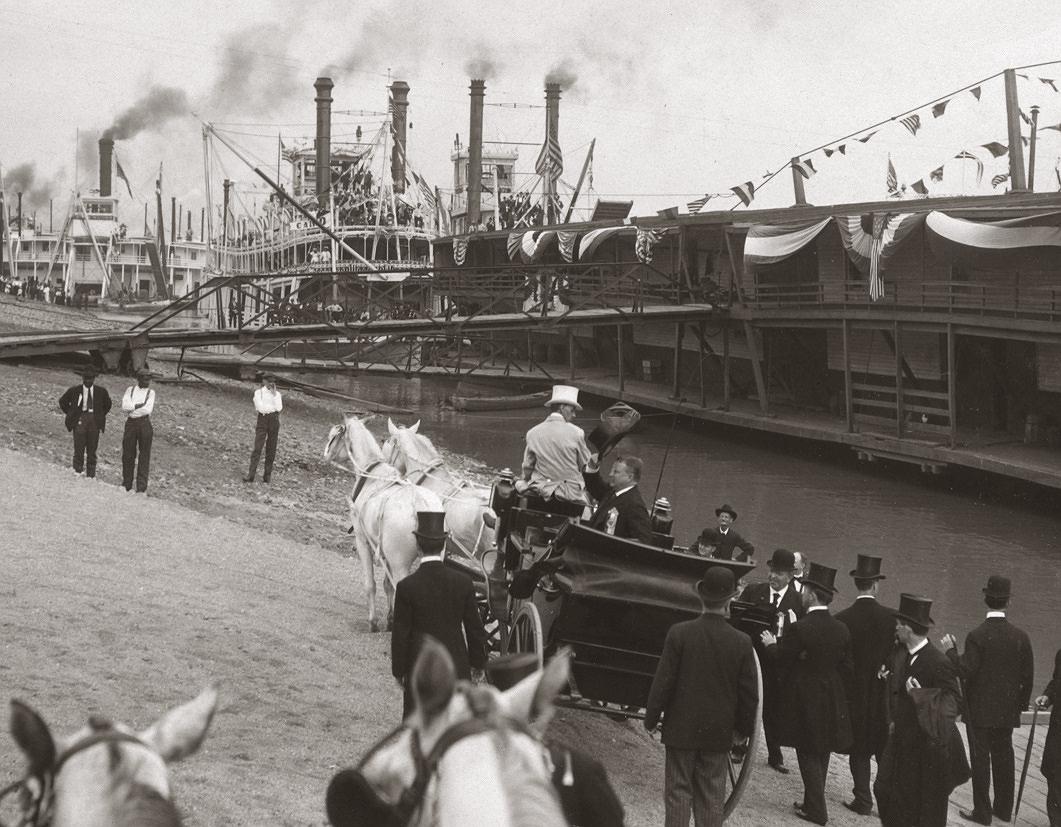
Teddy stereoview 1907 Carriage St Louis Levee
THIS IMAGE FROM THE LIBRARY OF CONGRESS SHOWS TEDDY DEPARTING OR ARRIVING FROM A DAY DOWNTOWN WHERE HE SPOKE AND ATTENDED A BANQUET. HERE HE'S SEEN RAISING HIS HAT TO SALUTE THE CROWD FROM A CARRIAGE DRAWN BY TWO WHITE HORSES AND THE DRIVER OF THE CARRIAGE WORE A WHITE HAT.
THIS IMAGE WAS DERIVED FROM THE RIGHT EYE OF A STEREOVIEW THAT I PLUMBED, CROPPED AND SEPIA TONED.
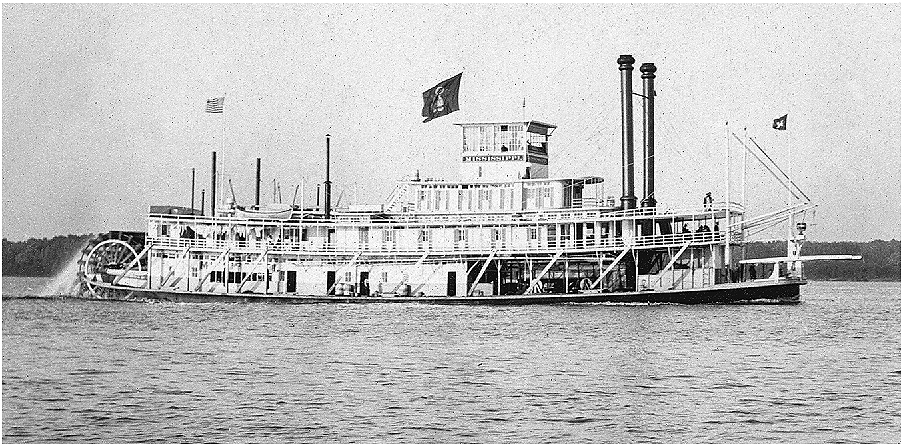
Attached starboard view of the boat with the Presidential colors flying from the pilot house.

A photo of Teddy returning waves from passengers aboard the City of Saltillo which had pulled alongside the boat he was on.
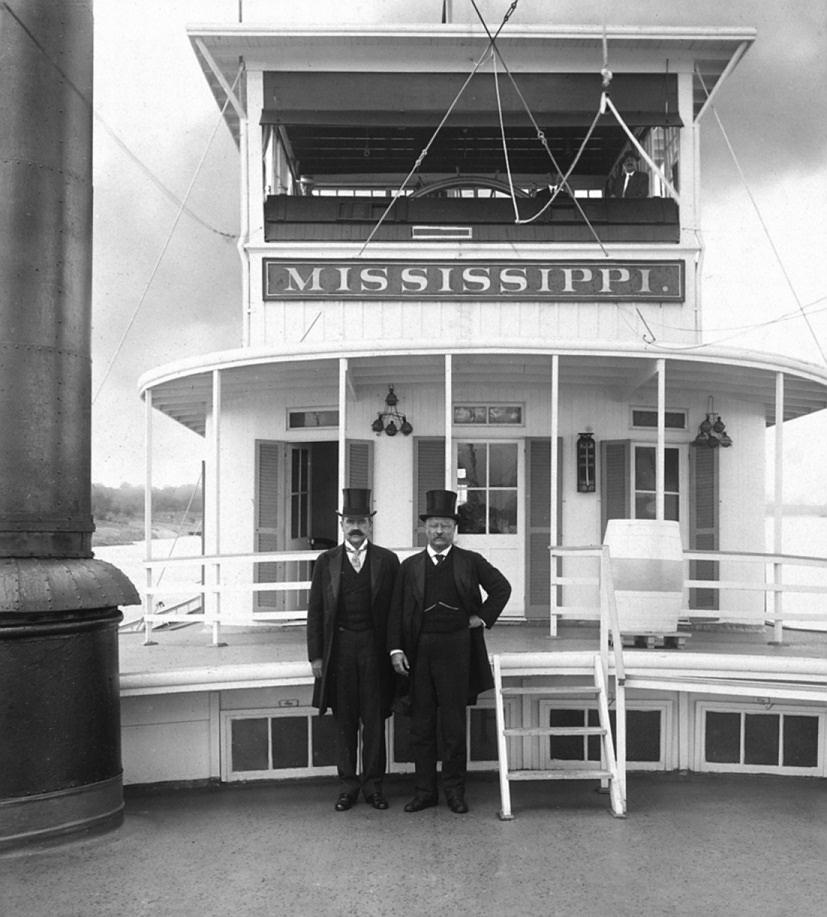
John McIlhenny (seen here with Teddy on the MISSISSIPPI in 1907) was a Louisiana boy and son of the inventor of Tabasco sauce.
McIlhenney was promoted to liutenant in Teddy Roosevelt's Rough Riders after "claiming" to have saved T.R. from a sniper's bullet. I put quotes around the word claiming because that's what McIlhenny's biography says. It seems to cast some doubt on this distinction.
Here's a letter from Teddy to his son which makes a nice caption for the picture. From reading this it seems that T.R. may have confused the "Texas" with the pilot house.
107. PECULIARITIES OF MISSISSIPPI STEAMBOATS
On Board U. S. S. Mississippi, Oct. 1, 1907.
DEAR ARCHIE: .....
I am now on what I believe will be my last trip of any consequence while I am President. Until I got to Keokuk, Iowa, it was about like any other trip, but it is now pleasant going down the Mississippi, though I admit that I would rather be at home. We are on a funny, stern-wheel steamer. Mr. John McIlhenny is with me, and Capt. Seth Bullock among others. We have seen wild geese and ducks and cormorants on the river, and the people everywhere come out in boats and throng or cluster on the banks to greet us.
October 4. You would be greatly amused at these steamboats, and I think you will like your trip up the Mississippi next spring, if only everything goes right, and Mother is able to make it. There is no hold to the boat, just a flat bottom with a deck, and on this deck a foot or so above the water stands the engine-room, completely open at the sides and all the machinery visible as you come up to the boat. Both ends are blunt, and the gangways are drawn up to big cranes. Of course the boats could not stand any kind of a sea, but here they are very useful, for they are shallow and do not get hurt when they bump into the bank or one another. The river runs down in a broad, swirling, brown current, and nobody but an expert could tell the channel. One pilot or another is up in the Texas all day long and all night. Now the channel goes close under one bank, then we have to cross the river and go under the other bank; then there will come a deep spot when we can go anywhere. Then we wind in and out among shoals and sand-bars. At night the steamers are all lighted up, for there are a dozen of them in company with us. It is nice to look back at them as they twist after us in a long winding line down the river.
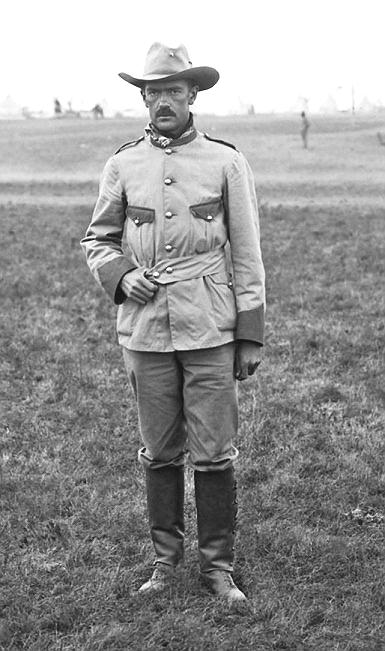
Photo of McIlhenny in uniform taken during the war in 1898. He is easily recognizable as the same gentleman standing next to Teddy aboard the MISSISSIPPI (above).
I've been corresponding for a while with singer and song writer Charlie Ipcar who is researching the history of steamboat songs and writing some new ones of his own. Charlie recently visited Avery Island and visited the archives of the McIlhenny "Tabasco" family. In regards to whether McIlhenny saved Teddy's life when they were in the Rough Riders together during the Spanish American War, Shane Bernard, curator of the archives, responded to Charlie's inquiry about that incident.
Charles,
This is very interesting. Roosevelt says in his memoir that McIlhenny was promoted twice for "galantry in action"; but when I interviewed John's son, Jack, he told me that his father had saved Roosevelt's life, pulling him down just as a sniper took a shot at Roosevelt; and that the bullet made a hole in Roosevelt's hat; and that Roosevelt, disliking the idea of owing his life to someone else, convinced John not to reveal what had happened. Roosevelt was indeed appreciative, however, and certainly had a positive impact on John's career, inviting him to serve in his administration in Washington.
- Shane K. Bernard, Ph.D.
Historian & Curator
McIlhenny Company
Avery Island LA 70513
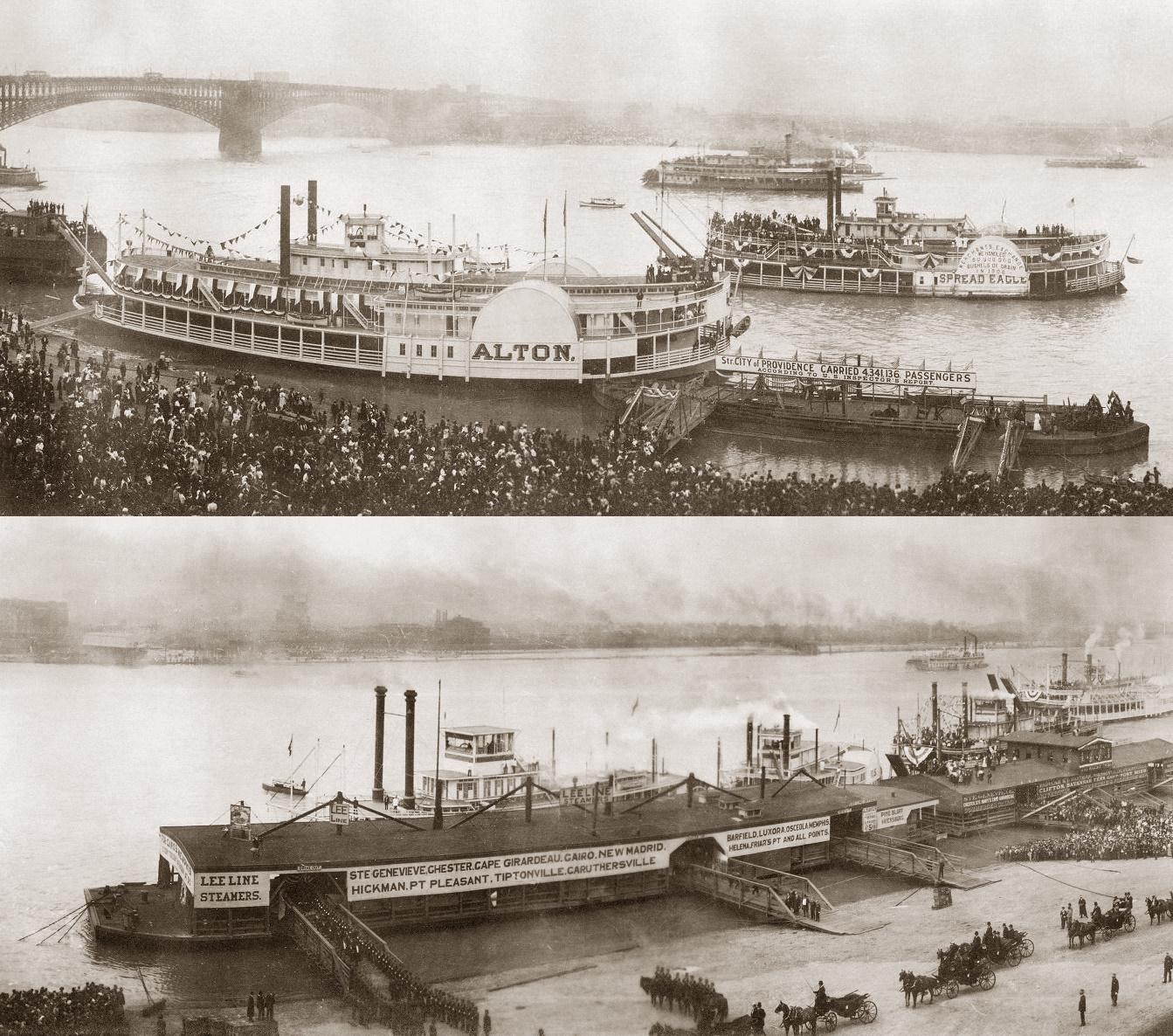
Left and right halves of a recently obtained original panoramic photo print published by STAR PHOTO of St. LOUIS, MO Copyright 1907
The panorama was taken on October 2nd, 1907 from a high vantage point. Overall size of the print is 9 1/2 X 39 1/2 inches.
The Eads Bridge in the distance on the Mississippi with the steamers ALTON and SPREAD EAGLE are prominently displayed in the left half of the panorama (in the top spot).
The photo below that (the right half of the panorama) includes the steamboat U.S. Inspection steamer MISSISSIPPI which had transported Roosevelt from Keokuk. The MISSISSIPPI is the first boat on the left recognizable from her outsized pilot house, visible on the far side of the Lee Line Wharf Boat.
An honor guard is lined up on either side of the ramp leading from the wharf boat to the levee and a procession of dignitaries probably including President Theodore Roosevelt is filing in single file down the ramp to the levee. About half a dozen fancy horse drawn carriages can be seen on the waterfront who will take the honored guests first to the Jai Alai building where Roosevelt gave a speech, a facsimile of his manuscript is online here: theodorerooseveltcenter.org
"Roosevelt addressed the City of St. Louis advocating the financial benefits of thoughtful transportation development, drawing comparisons to the Suez and Panama Canals. He also discussed the importance of maintaining and developing the Navy."
From the Jai Alai building the guests were taken by carriages to the Jefferson Hotel where luncheon was served. A contemporary newspaper article below gives an account of the lavish hospitality of St. Louis gave Roosevelt that day.
Aspen Daily Times
Aspen, Colorado
Published October 3, 1907
President Arrives at St. Louis on River Steamboat
Distinguished Assemblage Greets the Popular Chief Executive
St . Louis , MO.
October 2, 1907
For the first time within the memory of the resent generation a chief executive of the nation today arrived in the Mound city by steamboat and departed from the city in the same manner.
President Theodore Roosevelt on hoard the steamboat MISSISSIPPI from Keokuk , reached St. Louis shortly alter 1 o'clock this morning.
Accompanying him on another craft were the members of the Inland Waterway commission.
The President found St . Louis awaiting his arrival in gala attire.
Steamboats and other craft bedecked with flags filled the river.
Not since the palmy days before the war has St . Louis seen so many steamboats at one time.
They came from Evansville , Cairo, Alton, Kansas City, Keokuk and other river points and bought delegations of business men and others desirous of impressing upon the president and the members of the waterways commission the importance of the river traffic and the urgent necessity for improvements in the Mississippi and its chief tributaries.
As the president's boat came into sight it was greeted with deafening shrieks from the steamboat whistles, which were echoed by the cheers of the thousands of people who lined the river front and occupied positions of vantage on the wharfs and on the two great bridges spanning the Mississippi river.
It was a distinguished assemblage that greeted the president when he landed near the foot of Locust street. Included among those present were the governors of more than twenty states, members of congress, the mayor and other representatives of the city of St . Louis and a reception committee of the Business Men's league, which had the general arrangements in charge .
After the exchange of courtesies the president and his party were taken in carriages to the Jai Alai building , where he delivered his address. The route lay through Washington Avenue, Twelfth Street , Pine Street , Grand Avenue, Lindell Boulevard and other leading thoroughfares.
Flags were flying from every staff in the downtown section and the city was bright with bunting. Pictures of President Roosevelt greeted the eye at every turn.
Crowds lined the streets , anxious to get a glimpse at the chief magistrate and his appearance was always the signal for tumultuous cheers .
After the exercises at the Jai Alai building the president was escorted to the Jefferson hotel where he was entertained at luncheon.
Covers were laid for 400 and among the guests were the visiting governors and numerous other persons of note.
From the hotel the presidential party proceeded at once to to the wharf to re-embark on the Mississippi .
The departure was the signal for another great river demonstration similar to that which had greeted the president's arrival in the morning .
Scores of boats will accompany the president's boat down the river as far as Cairo, which is to be the next stopping point and which city will be reached according to schedule at 9 o'clock tomorrow morning.
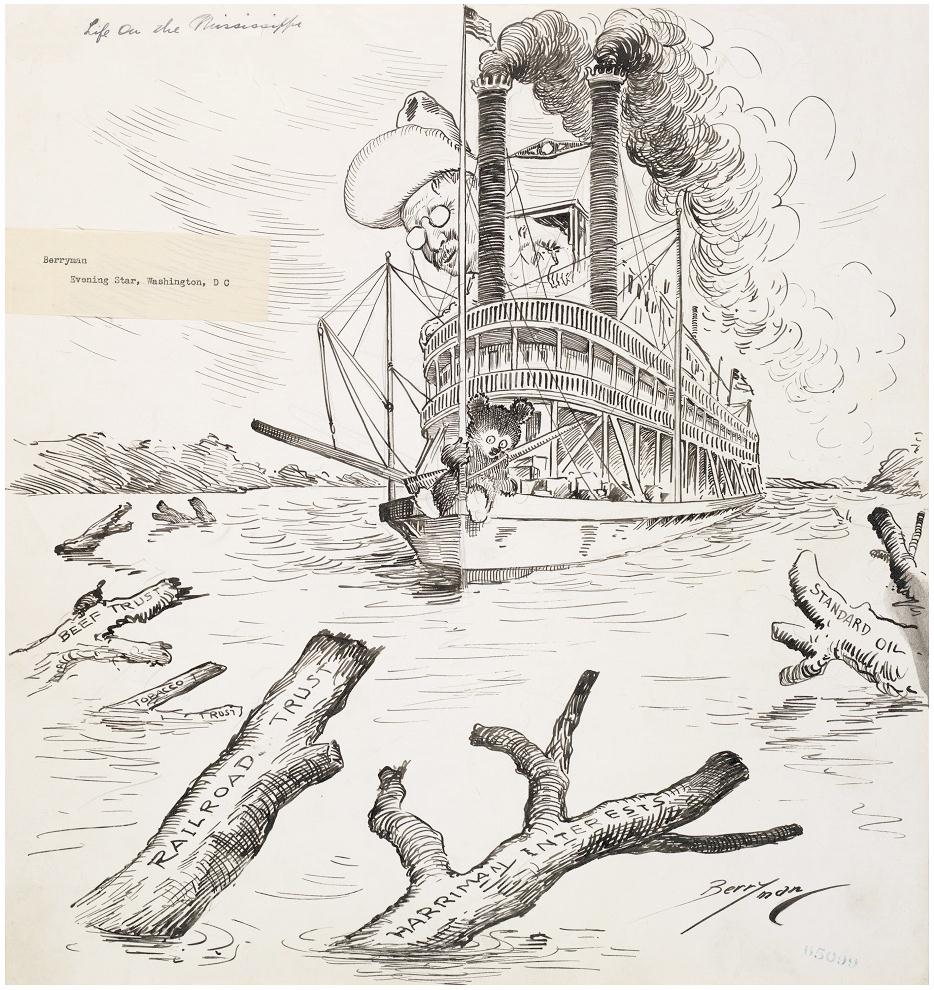
THIS CARTOON OF TEDDY ROOSEVELT in a steamboat pilot house with his "mascot teddy bear" on the bow behind the jack staff by Clifford Berryman was published while Teddy was descending the river on the U.S. Inspection boat MISSISSIPPI.
The cartoonist Berryman represented the "Trusts" that Teddy abhorred as "snags" in the river that Roosevelt opposed. Below excerpt from Humanities Texas that gives further details into the cartoon.
humanitiestexas.org
Political cartoon by Clifford Berryman
Life on the Mississippi, October 2, 1907
Published in The Evening Star, Washington D.C.
U.S. Senate Collection
Center for Legislative Archives
National Archives
One of the primary political controversies during Theodore Roosevelt's administration was the prevalence of "trusts," which are groups made up of large corporations collaborating to unfairly prevent competition.
Roosevelt's administration sued forty-five companies under the Sherman Antitrust Act in an attempt to break up their monopolies, leading to Roosevelt being hailed as a "trust buster."
In this Clifford Berryman cartoon, Roosevelt is portrayed trying to guide his way through a Mississippi River filled with logs bearing the names of various trusts obstructing his way. The cartoon illustrates the difficulty Roosevelt faced navigating his presidency through a political landscape filled with trusts.

With the exception of images credited to public institutions,
everything on this page is from a private collection.
Please contact Steamboats.com for permission for commercial use.*
All captions provided by Dave Thomson, Steamboats.com primary contributor and historian.
